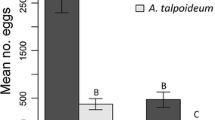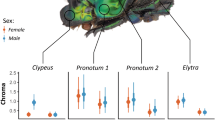Summary
To examine the importance of covariance between stages in traits related to foraging, we quantified the relationships between reproductive success and sizerelated variability in weight gain in juvenile and adult instars of the crab spider Misumenoides formosipes (Araneae: Thomisidae). Prereproductive weight and fecundity are both highly correlated with carapace width, a linear measure of size which does not change within an instar. In field populations, adult females with larger carapaces gain more weight and are more likely to reproduce than females with smaller carapaces. The growth rate of spiders fed ad libitum in the laboratory is unrelated to size, suggesting that size-related differences in the field are due to variation in prey-capture success. Adult females with a carapace width less than 3.4 mm comprised 22% of the population, but were never found to reproduce. Of the individuals that did reproduce, a 17% increase in carapace width resulted in a 100% increase in fecundity. Juvenile stages must be examined to understand adult foraging and reproductive success, because the net weight gained by juvenile instars determines adult size. The final weight gained by spiders in the antepenultimate and penultimate instars explained nearly all the variation in carapace width in the penultimate and adult instars, respectively. We found that constraints on foraging in late juvenile stages are different from the adult stage. Penultimate foraging behavior differs from that of adults, because of constraints on foraging in the period preceding ecdysis. Additionally, in both late juvenile instars, carapace width had little or no effect on the final weight gained within the instar suggesting that factors that affect foraging are different between the juvenile and adult stages. These analyses stress the fact that to fully understand the effects of foraging on reproductive success, we must examine stage-specific constraints throughout an organism's life history.
Similar content being viewed by others
References
Alcock J (1984) Long-term maintenance of size variation in populations of Centris pallida (Hymenoptera: Anthophoidae). Evolution 38:220–223
Austin AD (1984) Life history of Clubiona robusta L. and related species (Araneae, Clubionidae) in South Australia. J Arachnol 12:87–104
Barkan CPL (1990) A field test of risk-senstive foraging in Blackcapped Chickadees (Parus atricapillus). Ecology 71:391–400
Belovsky GE, Slade JB, and Stockhoff BA (1990) Susceptibility to predation for different grassoppers: an experimental study. Ecology 71:624–634
Bergelson JM (1985). A mechanistic interpretation of prey selection by Anax junius larvae (Odonata: Aeschnidae). Ecology 66:1699–1705
Blakely N (1981). Life history significance of size-triggered metamorphosis in milkweed bugs (Oncopeltus). Ecology 62:57–64
Brown KM (1981) Foraging ecology and niche partitioning in orbweaving spiders. Oecologia 50:380–385
Carter MC, Dixon AFG (1982) Habitat quality and the foraging behaviour of coccinellid larvae. J Anim Ecol 51:865–878
Dingle H, Blakley NR, and Miller ER (1980) Variation in body size and flight performance in milkweed bugs (Oncopeltus). Evolution 34:371–385
Dodson G, Beck M (1993) Precopulatory guarding of penultimate females by male crab spiders, Misumenoides formosipes. Animal Behaviour (in press)
Ehlinger TJ (1990) Habitat choice and phenotype-limited feeding efficiency in bluegill: individual differences and trophic polymorphism. Ecology 71:886–896
Eisenberg RM, Hurd LE, Bartley JA (1981) Ecological consequences of food limitation for adult mantids (Tenodara aridifolia sinenaia Saussure). Am Mid Nat 106:209–218
Enders F (1975) Change of web site in Argiope spiders (Araneidae). Am Mid Nat 94:484–490
Foelix RF (1982) The biology of spiders. Harvard University Press, Cambridge, Massachusetts
Formanowicz Jr DR (1982) Foraging tactics of larvae of Dysticus verticalis (Coleoptera: Dytiscidae): the assessment of prey density. J Anim Ecol 51:757–767
Fretwell SD (1972) Populations in a seasonal environment. Princeton University Press, Princeton, New Jersey
Fritz RS, Morse DH (1985) Reproductive success and foraging of the crab spider Misumena vatia. Oecologia 65:194–200
Galis F (1990) Ecological and morphological aspects of changes in food uptake through the ontogeny of Haplochromis piceatus. In: RN Hughes (ed) Behavioural mechanisms of food selection. Springer-Verlag, Berlin, pp 281–300
Gertsch WJ (1939) A revision of the crab-spiders (Misumeninae) of America north of Mexico. Bull Am Mus Nat His 76:277–442
Gillespie RG, Caraco T (1987) Risk-sensitive foraging strategies of two spider populations. Ecology 68:887–889
Greenstone MH, Bennett AF (1980) Foraging strategy and metabolic rate in spiders. Ecology 61:1255–1259
Hassell MP, May RM (1984) From individual behaviour to population dynamics. In: RM Sibly, Smith RH (eds) Behavioral ecology: ecological consequences of adaptive behaviour. Blackwell Scientific Publications, London, England, pp 3–30
Hedrick AV, Riechert SE (1989) Genetically-based variation between two spider populations in foraging behavior. Oecologia 80:533–539
Helfman GS, Winkelman DL (1991) Energy trade-offs and foraging mode choice in American eels. Ecology 72:310–318
Jaeger RG, Lucas J (1990) On evaluation of foraging strategies through estimates of reproductive success. In: RN Hughes (ed) Behavioural mechanisms of food selection. Springer-Verlag, Berlin, pp 83–94
Johnson LK (1982) Sexual selection in a brentid weevil. Evolution 36:251–262
Juliano SA (1985) The effects of body size on mating and reproduction in Brachinus lateralis (Coleoptera: Carabidae). Ecol Ent 10:271–280
Kaston BJ (1972). How to know the spiders. Wm.C. Brown Co. Dubuque, Iowa
Kessler A (1971) Relation between egg production and food consumption in species of the genus Pardosa (Lycosidae, Araneae) under experimental conditions of food-abundance and foodshortage. Oecologia 8:93–109
Lande R (1982) A quantitative genetic theory of life history evolution. Ecology 63:607–615
Lomnicki A (1988) Population ecology of individuals. Princeton University Press, New Jersey
Matsura T, Morooka K (1983) Influences of prey density on fecundity in a mantis Paratenodera angustipennis (S.). Oecologia 56:306–312
Mittelbach G (1981) Foraging efficiency and body size: a study of optimal diet and habitat use by bluegills. Ecology 62:1370–1386
Montgomery TH (1909) Further studies on the activities of Araneads. Proc Nat Acad Sci 55:548–569
Morse DH (1979) Frey capture by the crab spider Misumena calycina (Araneae: Thomisidae). Oecologia 39:309–319
Morse DH (1981) Prey capture by the crab spider Misumena vatia (Clerck) (Thomisidae) on three common native flowers. Am Mid Nat 105:358–367
Morse DH (1983) Foraging patterns and time budgets of the crab spiders Xysticus emerotoni Keyserling and Misumena vatia (Clerck) (Araneae: Thomisidae) on flowers. J Arachnol 11:87–94
Morse DH (1985) Nests and nest site selection of the crab spider Misumena vatia (Araneae: Thomisidae). J Arachnol 13:383–390
Morse DH (1986) Foraging behavior of crab spiders (Misumena vatia) hunting on inflorescences of different quality. Am Mid Nat 116:341–347
Morse DH (1987) Attendance patterns, prey capture, changes in mass, and survival of crab spiders Misumena vatia (Araneae: Thomisidae) guarding their nests. J Arachnol 15:193–204
Morse DH (1988) Relationship between crab spider Misumena vatia nesting success and earlier patch-choice decisions. Ecology 69:1970–1973
Morse DH, Fritz RS (1982) Experimental and observational studies of patch choice at different scales by the crab spider Misumena vatia. Ecology 63:172–182
Morse DH, Fritz RS (1987) The consequences of foraging for reproductive success. In: Kamil AC, Krebs JR, Pulliam HR (eds) Foraging behavior. Plenum Press, New York, pp 443–456
Murakami Y (1983) Factors determining the prey size of the orbweb spider, Argiope amoena (L. Koch) (Argiopidae). Oecologia 57:72–77
Olive CW (1982) Behavioral response of a sit-and-wait predator to spatial variation in foraging gain. Ecology 63:912–920
Petersen B (1950) The relation between size of mother and number of eggs and young in some spiders and its significance for the evolution of size. Experientia 6:96–98
Pimm SL, Rosenzweig ML (1981) Competitors and habitat use. Oikos 37:1–6
Pimm SL, Rosenzweig ML, Mitchell W (1985) Competition and food selection: field tests of a theory. Ecology 66:798–807
Pollard SD (1989) Constraints affecting partial prey consumption by a crab spider. Diaca sp. indet. (Araneae: Thomisidae). Oecologia 81:392–396
Pulliam HR (1986) Niche expansion and contraction in a variable environment. Am Zool 26:71–79
Pyke GH, Pulliam HR, Charnov EL (1977) Optimal foraging: a selective review of theory and tests. Quart Rev Biol 52:137–154
Byke GH (1984) Optimal foraging theory: a critical review. Ann Rev Ecol Syst 15:523–575
Real LA (1980) On uncertainty and the law of diminishing returns in evolution and behavior. In: Staddon JER (ed). Adaptation to constraint: the allocation of limited resources in biology, psychology, and economics, Academic Press, New York, pp 37–64
Real L, Caraco T (1986) Risk and foraging in stochastic environments. Ann Rev Ecol Syst 17:371–390
Reynolds SE (1980) Integration of behavior and physiology in ecdysis. Adv Insect Physiol 15:475–595
Schoener TW (1971) Theory of feeding strategies. Ann Rev Ecol Syst 2:369–404
Sih A (1980) Optimal behavor: can foragers balance two conflicting demands? Science 210:1041–1042
Sokal RR, Rohlf FJ (1981) Biometry. 2nd edition. W.H. Freeman and Company, New York, New York
Spitze K (1985) Functional response of an ambush predator: Chaoborus americanus predation on Daphnia pulex. Ecology 66:938–949
Stearns SC (1977) The evolution of life history traits. Ann Rev Ecol Syst 8:145–172
Stephens DW, Krebs JR (1986) Foraging theory. Princeton University Press, Princeton, New Jersey
Suter RB (1990) Determinants of fecundity in Frontinella pyramitela (Araneae, Linyphiidae). J Arachnol 18:263–270
Turnbull AI (1962) Quantitative studies of the food of Lynyphia triangularis Clerck (Aranaeae: Lynyphiidae). Can Ent 94:1233–1249
Turnbull AI (1973) Ecology of the true spiders (Araneomorphae). Ann Rev Ent 18:305–348
Turner M (1979) Diet and feeding phenology of the green lynx spider, Peucetia viridans (Araneae: Oxyopidae). J Arachnol 7:149–154
Uchmanski J (1985) Differentiation and frequency distributions of body weights in plants and animals. Phil Trans R Soc Lond B 310:4–75
Vollrath F (1987) Growth, foraging, and reproductive success. In: Nentwig W (ed) Ecophysiology of spiders. Springer-Verlag, Berlin, pp 357–370
Walde SJ, Davies RW (1984) The effect of intraspecific interference on Kogotus nonus (Plecoptera) foraging behaviour. Can J Zool 62:2221–2226
Werner EE, Hall DJ (1979) Foraging efficiency and habitat switching in competing sunfishes. Ecology 60:256–264
Werner EE, Mittelbach GG (1981) Optimal foraging: field tests of diet choice and habitat switching. Am Zool 21:813–829
Werner EE, Gilliam JF, Hall DJ, Mittelbach GG (1983) An experimental test of the effects of predation risk on habitat use in fish. Ecology 64:1540–1548
Werner EE, Gilliam JF (1984) The ontogenetic niche and species interactions in size-structured populations. Ann Rev Ecol Syst 15:393–425
Wise DH (1976) Variable rates of maturation of the spider, Neriene radiata (Linyphia marginata). Am Mid Nat 96:66–75
Wise DH (1983) Competitive mechanisms in a food-limited species: relative importance of interference and exploitative interactions among labyrinth spiders. Oecologia 58:1–9
Wise DH (1984) Phenology and life history of the filmy dome spider (Araneae: Linyphidae) in two local Maryland populations. Psyche 91:267–288
Wise DH, Wagner JD (1992) Evidence of exploitative competition among young stages of the wolf spider Schizocosa ocreata. Oecologia 91:7–13
Author information
Authors and Affiliations
Rights and permissions
About this article
Cite this article
Beck, M.W., Connor, E.F. Factors affecting the reproductive success of the crab spider Misumenoides formosipes: the covariance between juvenile and adult traits. Oecologia 92, 287–295 (1992). https://doi.org/10.1007/BF00317377
Received:
Accepted:
Issue Date:
DOI: https://doi.org/10.1007/BF00317377




